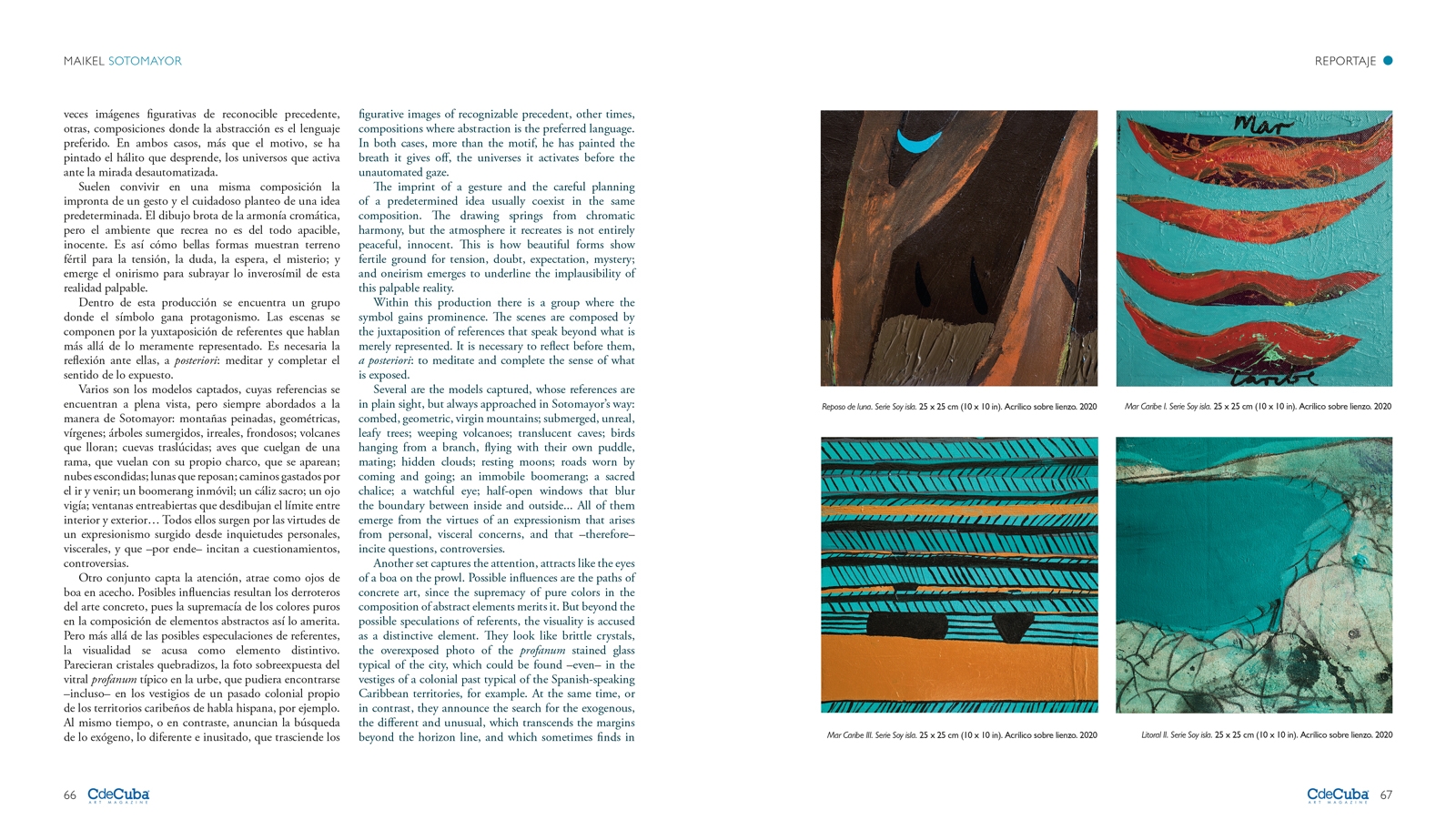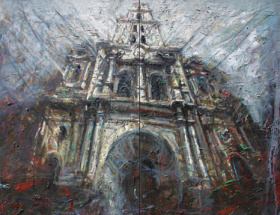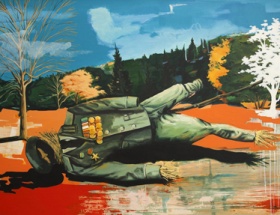Being Island: a Condition, an Attitude
By Nayr López García
For Maikel Sotomayor, landscape has been the neuralgic point of his most extended creative discourse. He conceives it as an entity to which he must return, with whom he lives and suffers. Rather than paying attention to appearances, he penetrates to its deepest, living parts, with the intention of renewing it and renewing himself before it.
In the latest moves of an imposed distancing, he has found in the island the core of his inspiration and, although he makes use of elements that characterize it to enunciate certain contexts, he does not limit himself to any one in particular. It is the insular notion, in a broad sense, which he wields from the exercise of fictionalizing the environment, of enhancing memory and its interpretation from the readjustments of memory. This is how Soy Isla (2020 series) was born, where the author extends his gaze beyond the margins of the surrounding context and imprints a certain regional character.
The dynamics and experiential, daily and existential questions of the mainland and the islands are different. The truth is that once you are born, grow up and live on an island, your daily life is permeated by the conditions of the context. The constant presence of the sea, the incident light, the unseasonable heat… make up a distinctive, powerful landscape. The horizon that is perceived, generally “blue”, separates realities, constitutes a border with the rest of the world. To know oneself detached from a great land mass creates a different temperament: the temperament and attitude of those who live in isolation.
It is not surprising then, that water is a motif of repeated appearance. Rain water, sea water, river water, lake, weeping, pearl… Shades of blue sometimes form figurative images of recognizable precedent, other times, compositions where abstraction is the preferred language. In both cases, more than the motif, he has painted the breath it gives off, the universes it activates before the unautomated gaze.
The imprint of a gesture and the careful planning of a predetermined idea usually coexist in the same composition. The drawing springs from chromatic harmony, but the atmosphere it recreates is not entirely peaceful, innocent. This is how beautiful forms show fertile ground for tension, doubt, expectation, mystery; and oneirism emerges to underline the implausibility of this palpable reality.
Within this production there is a group where the symbol gains prominence. The scenes are composed by the juxtaposition of references that speak beyond what is merely represented. It is necessary to reflect before them, a posteriori: to meditate and complete the sense of what is exposed.
Several are the models captured, whose references are in plain sight, but always approached in Sotomayor’s way: combed, geometric, virgin mountains; submerged, unreal, leafy trees; weeping volcanoes; translucent caves; birds hanging from a branch, flying with their own puddle, mating; hidden clouds; resting moons; roads worn by coming and going; an immobile boomerang; a sacred chalice; a watchful eye; half-open windows that blur the boundary between inside and outside… All of them emerge from the virtues of an expressionism that arises from personal, visceral concerns, and that –therefore– incite questions, controversies.
Another set captures the attention, attracts like the eyes of a boa on the prowl. Possible influences are the paths of concrete art, since the supremacy of pure colors in the composition of abstract elements merits it. But beyond the possible speculations of referents, the visuality is accused as a distinctive element. They look like brittle crystals, the overexposed photo of the profanum stained glass typical of the city, which could be found –even– in the vestiges of a colonial past typical of the Spanish-speaking Caribbean territories, for example. At the same time, or in contrast, they announce the search for the exogenous, the different and unusual, which transcends the margins beyond the horizon line, and which sometimes finds in the idyll the utopias of the unknown.
Between the two groups appears, sometimes merged, a sample where the panoramic sketch collects and captures the contemplation from a distance. Perhaps with a hint of a certain passivity, this section within the series allows us to know the experience with a looser air, to receive the heartbeat of the landscape from the encompassing perspective of one who stops to observe as a whole. Although, I must warn –be careful with this apparent passivity!–, the artist does not resort to mere presentation and, when he bets on it, he always places the right signs to insinuate much more than what he exposes.
Sotomayor’s islands are temperament, color, sound, movement, history, attitude… In this journey to the very essence of the insular feeling, he has recreated a discourse with identity nuances, where he does not succumb to the attractions of hackneyed and well-known methodologies, but rather imprints with his own stamp an authentic and personal imaginary. This series is, in short, the result of delving into those horizons, of living the landscape.






